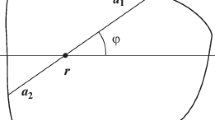Abstract
Mobile wireless communications, which includecellular telephones, land mobile radio, and personalcommunications systems, have experienced enormous growthover the last decade. Data services represent a critical component of future wirelesscommunications, but have received little attention sofar. While some attention has been given to specializedmobile data networks, less has been directed at the ongoing design of data services in evolvingthird generation digital cellular wireless networks. Inthis work we present the results of a simulation studythat explores the performance of a Reservation Random Access (RRA) scheme for transmittingdata packets over a common radio broadcast channel in acellular radio environment. In addition to voicetraffic, we consider data packet traffic generated by interactive applications. It is expected thatsuch applications will be very important in thirdgeneration wireless access mobile communication systems.Through an extensive simulation study of the data message delay distribution, we show that theproposed RRA scheme, originally designed under thePoisson data message arrival process assumption, canalso efficiently operate and be optimized under theextremely bursty data message arrival processcharacterized by independent, identically distributed,Pareto message interarrival times.
Similar content being viewed by others
REFERENCES
D. J. Goodman, Cellular packet communications, IEEE Transactions on Communications, Vol. COM-38, No.8, pp. 1272–1280, 1990.
S. Nanda, D. J. Goodman, and U. Timor, Performance of PRMA: A packet voice protocol for cellular systems, IEEE Transactions on Vehicular Technology, Vol. 40, pp. 584–598, 1991.
B. Mukherjee, Integrated voice-data communication over highspeed fiber optic networks, IEEE Computer Magazine, Vol. 24, No.2, pp. 49–58, 1991.
V. Paxson and S. Floyd, Wide area traffic: The failure of Poisson modeling, IEEE/ ACM Transactions on Networking, Vol. 3, No.3, pp. 226–244, 1995.
G. Anastassi, D. Grillo, L. Lenzini, and E. Mingozzi, A bandwidth reservation protocol for speech/ data integration in TDMA-based advanced mobile systems, International Journal of Wireless Information Networks, Vol. 3, No.4, pp. 243–252, 1996.
W. Willinger, M. Taqqu, R. Sherman, and D. Wilson, Self-similarity through high-variability: Statistical analysis of Ethernet LAN traffic at the source level, IEEE/ ACM Transactions on Networking, Vol. 5, No.1, pp. 71–86, 1997.
W. Lerand, M. Taqqu, W. Willinger, and D. Wilson, On the self-similar nature of the Ethernet traffic (extended version), IEEE/ACM Transactions on Networking, Vol. 2, No.1, pp. 1–16, 1994.
M. Taqqu, W. Willinger, R. Sherman, and D. Wilson, Proof of a fundamental result in self-similar traffic modelling, Computer Communications Review, Vol. 27, pp. 5–23, 1997.
B. Arnold, Pareto Distributions, International Cooperative Publishing House, Baltimore, MD, 1983.
M. Paterakis, L. Georgiadis, and P. Papantoni-Kaza kos, A full sensing window RA algorithm for networks with strict delay constraints, Algorithmica, Vol. 4, pp. 321–328, 1989.
P. T. Brady, A technique for investigating on-off patterns of speech, Bell Systems Technical Journal, January 1965.
T. Suda and T. Bradley, Packetized voice/ data integrated transmission on a token passing ring local area network, IEEE Transactions on Communications, Vol. COM-37, No.3, pp. 238–244, 1989.
J. M. DeVile, A reservation multiple access scheme for a future universal mobile telecommunication s system. In Proceedings of the 7th IEE Conference on Mobile and Personal Communications, Brighton, UK, pp. 210–215, December 1993.
J. Dunlop, J. Irvine, D. Robertson, and P. Cosimini, Performance of a statistical multiplexed access mechanism for a TDMA radio interface, IEEE Personal Communication s, Vol. 2, No.3, pp. 56–64, 1995.
D. C. Cox, Wireless personal communications: What is it?” IEEE Personal Communications, Vol. 2, No.2, pp. 20–35, 1995.
A. C. Cleary and M. Paterakis, Design and performance evaluation of an RRA scheme for voice data channel access in outdoor microcellular wireless environments. In B. Jabbari, P. Godlewski, and X. Langrange (eds.), Multiaccess, Mobility and Teletraffic for Personal Communication, Kluwer, Dordrecht, pp. 117–130, 1996; an extended version is to appear in the ACM Wireless Networks Journal.
Raif Onvural, Asynchronous Transfer Mode Networks: Performance Issues, Artech House, Boston, 1994.
I. Rombogiannakis, Design and performance evaluation of an RRA protocol for voice-data integration in microcellular wireless environments, Diploma Thesis, Department of Electronics and Computer Engineering, Technical University of Crete, Greece, 1996 [in Greek].
M. Paterakis and P. Papantoni-K azakos, A simple window random access algorithm with advantageous properties, IEEE Transactions on Information Theory, Vol. 35, No.5, pp. 1124–1130, 1989.
Rights and permissions
About this article
Cite this article
Rombogiannakis, I., Paterakis, M. Voice/Data Integrated Wireless Channel Access in Third Generation Digital Cellular Networks: The Performance of Bursty Data Generated by Interactive Applications. International Journal of Wireless Information Networks 5, 1–12 (1998). https://doi.org/10.1023/A:1018880427403
Issue Date:
DOI: https://doi.org/10.1023/A:1018880427403




